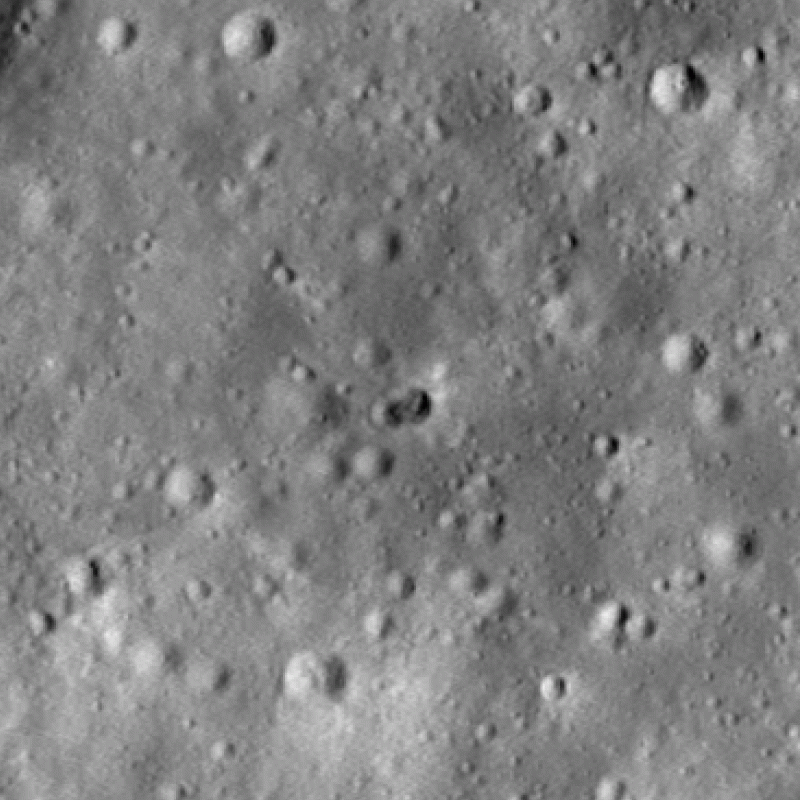
A mystery rocket has hit the lunar surface. Late in 2021, astronomers spotted what turned out to be a spent rocket body hurtling toward Earth’s moon, and NASA officials have no idea where it came from. The rocket hit the lunar surface this spring, leaving an interesting crater – actually two – that may help to identify its source.
The impact site was imaged by NASA’s Lunar Reconnaissance Orbiter, and the satellite’s operators described it this way in a June 24, 2022 press release:
Impact occurred March 4, 2022, with NASA’s Lunar Reconnaissance Orbiter later spotting the resulting crater. Surprisingly the crater is actually two craters, an eastern crater (18-meter diameter, about 19.5 yards) superimposed on a western crater (16-meter diameter, about 17.5 yards).
Weird crater could help solve the mystery
That double-crater impact could be the key to ID’ing the mystery rocket. NASA says the unusual formation could only come from an impactor of a certain shape:
The double crater was unexpected and may indicate that the rocket body had large masses at each end. Typically a spent rocket has mass concentrated at the motor end; the rest of the rocket stage mainly consists of an empty fuel tank. Since the origin of the rocket body remains uncertain, the double nature of the crater may indicate its identity.

By comparison, NASA says previous rocket body impact on the lunar surface look nothing like the new, enigmatic scaring:
No other rocket body impacts on the Moon created double craters. The four Apollo SIV-B craters were somewhat irregular in outline (Apollos 13, 14, 15, 17) and were substantially larger (greater than 35 meters, about 38 yards) than each of the double craters. The maximum width (29 meters, about 31.7 yards) of the double crater of the mystery rocket body was near that of the S-IVBs.
Whose rocket is this?
Bill Gray, an amateur astronomer who took the lead in trying to unmask the owners of the errant rocket body, at first thought it must be a SpaceX vehicle, but eventually decided it must be part of a Chinese launch, a booster from the Chang’e 5-T1 lunar mission, which launched in 2014. The rocket body was discovered – and originally misidentified – in 2015.
But, despite data that confirmed the ID, Gray says the Chinese government denied ownership, and it’s his opinion they’ve made an honest mistake, confusing Chang’e 5-T1 and the similarly named Chang’e 5:
I think the Ministry of Foreign Affairs simply got two different, but similarly named, lunar missions mixed up.
I should note that many have gotten these two missions mixed up before at one time or another. (Picture my hand raised here.) Given that, I think this was probably an honest error on the part of the Foreign Ministry.
Further, Gray says he’s convinced from his analysis the rocket body was part of Chang’e 5-T1:
In a sense, all this remains “circumstantial” evidence. But I would regard it as fairly convincing evidence, the sort where the jury would file out of the courtroom and come back in a few minutes with a conviction.

China says its rocket burned in orbit
According to a report from Spacenews.com, the Chinese believe the Chang’e 5-T1 booster Gray thinks is the lunar impactor burned up in the atmosphere:
“According to China’s monitoring, the upper stage of the rocket related to the Chang’e-5 mission entered into Earth’s atmosphere and completely burned up,” Foreign Ministry spokesperson Wang Wenbin said Feb. 21.
However, this may be the misidentification Gray pointed out, as the mission named by the ministry’s spokesperson in Spacenews.com’s article is the wrong one.
According to reporting by The Verge, the US Space Force confirmed Chang’e 5-T1 did not burn in Earth’s atmosphere:
Some other confusion revolved around the fact that the Space Force’s 18th Space Control Squadron (18SPCS) — which keeps track of space debris around Earth — noted on its tracking website that the rocket from the Chang’e 5-T1 mission returned to our planet about a year after launch and burned up in our atmosphere. However, the 18SPCS later confirmed in a statement to The Verge that the Long March 3C from the flight did not actually reenter our atmosphere and has been in space ever since its launch.
Bottom line: A mystery rocket body has struck the lunar surface leaving an unusual crater, and where the rocket body came from is uncertain.
The post Mystery rocket impacts moon first appeared on EarthSky.
0 Commentaires